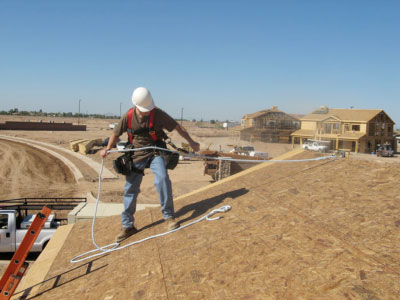Residential contractors are being given yet another temporary reprieve in implementing a 2010 federal directive on fall protection.
In an effort to encourage greater compliance, the Occupational Safety and Health Administration has extended the “temporary enforcement measure” period for its Compliance Guidance for Residential Construction (STD 03-11-002) to Dec. 15.
The directive requires employers to provide roofers and construction workers with fall-protection equipment whenever work is performed six feet or higher above the ground.

The directive, published in December 2010, replaces fall-protection policies issued in June 1999.
The “temporary enforcement measures” include priority free on-site OSHA compliance assistance, penalty reductions, extended abatement dates, and increased outreach.
Fatalities from falls are the number-one cause of workplace death in construction, OSHA says.
Months of ‘Temporary Enforcement’
The directive on fall protection in residential construction was issued in December 2010 and replaces policies issued in 1999. The directive was to take effect June 16, 2011.
A three-month phase-in period was then implemented June 16, 2011, through Sept. 15, 2011.
Then, in September 2011, the agency began a period of “temporary enforcement” measures that was scheduled to close March 15, 2012. The temporary period was then extended until Sept. 15.
Last week, however, the agency said it would keep the measures in place until Dec. 15.
‘Common-Sense’ Approach
OSHA said that from March 1 to June 30 of this year, its Compliance Assistance Specialists (CASs) conducted 809 outreach activities related to residential fall protection.
From Oct. 1, 2011, to June 30, 2012, OSHA’s On-site Consultation Projects conducted 2,527 on-site visits, 438 presentations and 925 training sessions related to fall protection in residential construction.
OSHA said the agency was taking a “common-sense” approach to enforcement and would continue to work with employers to ensure understanding of, and facilitate compliance with, the new policy.
Protection Requirements
The directive requires that workers engaged in residential construction six feet or more above lower levels be protected by conventional fall protection (i.e., guardrail systems, safety-net systems or personal fall-arrest systems) or other fall-protection measures allowed elsewhere in 1926.501(b).
If an employer can demonstrate that such fall protection is infeasible or presents a greater hazard, the employer may implement a plan that meets the requirements of 1926.502(k).
Alternative measures must use safe work practices that eliminate or reduce the possibility of a fall, OSHA said.
The directive, details of the phase-in policy, a presentation, and other guidance materials are available here.





